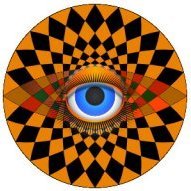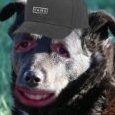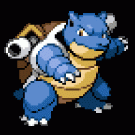
Dazzler
-
Posts
216 -
Joined
-
Last visited
Reputation Activity
-
 Dazzler got a reaction from R C-R in Histogram: Luminance is missing! Need help :(
Dazzler got a reaction from R C-R in Histogram: Luminance is missing! Need help :(
Just to prove what I just said, I took the green channel view and pasted it over the combined channels and just 'un-normalised' (squashed) it down to the same size it was and you can see it's the reason that area of combined colour exists.
-
 Dazzler reacted to Murfee in Can't get the color replacement brush to work
Dazzler reacted to Murfee in Can't get the color replacement brush to work
There is a quick & easy way to change the black lines to any colour you need. You can add a shape under the lines and colour it how you like then nest it under your lines layer, drag it over the lines layer to the right of the thumbnail and release when the long horizontal highlight shows. You can also use the pen tool to roughly draw the area you want coloured, then fill this shape with a solid colour or a gradient, then nest under the lines, the shapes remain editable so you can change the colours as needed. You can also add another pixel layer, paint whatever colour or pattern you need then nest this to the black line layer.
-
 Dazzler reacted to GarryP in Crop tool doesn't snap to guides and center?
Dazzler reacted to GarryP in Crop tool doesn't snap to guides and center?
Ah, I see what you mean now. Thanks for the videos, they make it much clearer.
I would agree that this functionality would be good to add.
As for the snapping to the centres of the layer, we have this when dragging layers so why not also have it when dragging the crop box?
As for the symmetrical resizing, we have this when resizing layers via the Shift/Ctrl modifiers so why not when we are resizing the crop box too?
Both sound like very reasonable requests to me.
-
 Dazzler reacted to Medical Officer Bones in af Photo NOT precise
Dazzler reacted to Medical Officer Bones in af Photo NOT precise
I assume you turned on "Force Pixel Alignment"? If not, Photo will work with decimal pixel values, resulting in ugly anti-aliased copies when positioning to a half-pixel value, for example.
The trouble is that if you already moved bitmap objects, turning on this setting does not fix the issue initially: first the object needs to be moved again, and then the setting kicks in. And when "Move by Whole Pixels" is active too, the blurred version will not "unblur". So turn off this option first, then turn on Force Pixel Alignment. Then move the bitmap, and it should clear up.
The combination of these two settings can be a potential pixel art killer, so be aware of the effects.
-
 Dazzler got a reaction from Old Bruce in Exporting resizes image
Dazzler got a reaction from Old Bruce in Exporting resizes image
...actually I think I just worked out what the MBWP is for - if you are creating small sprites/icons and find a nice alignment of pixels using a vector that is sat off of the pixel grid, it means you can move it around without losing that pixel setup (ie. keeping the anti-aliasing the same). That might actually be important in certain situations.
-
 Dazzler got a reaction from driftinsider in Adding composition areas in Affinity Photo?
Dazzler got a reaction from driftinsider in Adding composition areas in Affinity Photo?
Or just get the entire set of Photo , Designer and Publisher . Seriously though, just drop your cloud subs for a couple of months and there's the money to do just that!
From what it loooks like you're doing I'd say Designer is a much better tool for that than working in a raster package like Photoshop. Give it a spin and I think you'll see the benefits fairly early on. PS = raster with some vector abilities. Designer = Vector with some raster abilities. Publisher + Designer + Photo = everything in one place using the personas.
-
 Dazzler got a reaction from Alfred in Exporting resizes image
Dazzler got a reaction from Alfred in Exporting resizes image
I've always thought of it as an additional constraint, however the two can't really co-exist, so the MBWP takes precedence. Personally I think if you turn on the MBWP it should turn off the FPA button, as that clearly no longer applies.
-
 Dazzler got a reaction from firstdefence in Macro question.
Dazzler got a reaction from firstdefence in Macro question.
Yeah that's a real shame, and a bit of a surprise. However, in general I really like the way they've separated the 'macro' parts from the image type in Photo - so converting to different formats whilst applying a macro at the same time is a breeze compared to a PS macro, where you have to deal with the 'override file open' type things that never seem to work as you'd expect them to. It's early days with this software - and once they've cracked these early bugs it should become a fantastic piece of software.
-
 Dazzler got a reaction from ArthurFfox in Problem selecting transparent color
Dazzler got a reaction from ArthurFfox in Problem selecting transparent color
Alternatively, the Select > Select Sampled Color... option when clicked on will give a default selection around most of the items of all colours, however when you then click on a colour on the image it'll sample that colour and select items that are that colour and the tolerance control allows you to expand that range a bit if needs be. You can also keep clicking around in the image area whilst the dialogue is open to select slightly different colours etc.
-
 Dazzler got a reaction from Gigatronix Pete in Exporting resizes image
Dazzler got a reaction from Gigatronix Pete in Exporting resizes image
It happens in other software too. It's because if you take a one pixel line and position it half a pixel to the left (the fractional part of the position) it needs to now render that across two pixels (it will most likely do two half opacity lines instead of one full opacity line), to make it look like that's where it is sat. It's called antialiasing and is the whole reason the 'snap to pixel' style constraints exist.
-
 Dazzler got a reaction from Fixx in What is the best way to warm up this image?
Dazzler got a reaction from Fixx in What is the best way to warm up this image?
Add a curves adjustment, then under the histogram there is a dropdown selection for the channel (normally set on Master), switch it to blue. Then, just click and drag on the middle of the line in the histogram and drag down a bit ... it's a live preview so you'll see immediately the effect this has on the image. The histogram is showing the levels in the image ranging from shadows on the left to highlights on the right, and you'll see a peak (or maybe several peaks) where most of your image is sat in that range. You can create several points on the curve and drag them around to affect maybe only the darker areas or create an s-curve to enhance or reduce contrast in a particular tone range. By choosing blue channel you'll only be affecting the levels of the blue, therefore having an effect on the hues in the image, pulling down making it less blue and pushing up increasing the blue and making the image cooler. By using curves you can leave the white area alone, whereas colour balance will have a more general effect.
-
 Dazzler got a reaction from Callum in Stacking for Noise reduction
Dazzler got a reaction from Callum in Stacking for Noise reduction
To answer this, there is no minimum, but to explain it better you need to understand how it works. So it's working on the law of averages, whereby if you take a single pixel on the image and it had some noise (random value between 0 and 255 for example, although in reality it would be across three channels and unlikely to hit the extremeties of the value range). For the sake of simplicy let's imagine the orignal image without noise should be the value 127. So if the noise on the original image changes the value to 254. You now need another image with noise at a value of 0 to bring that back in line to where it should be ((254 + 0)/2 = 127). Of course noise isn't likely to be that severe, but it's very unlikely that with 2 images the two noise values would cancel each other out perfectly, but in theory the end result of two images should be closer in truth than either one of the images alone. Obviously, the more images used in the process the more they are likely to smooth each other out. In theory, each noisey value should be biased towards the original 'correct' value, so after adding them all up and dividing the result you should be pretty close to the true value. So yes you can do it with any number of images, but the more the merrier. Two images is unlikely to make a lot of difference, but you may see some improvement. Two should still be better than one. However, there must be a point at which adding more images also becomes fairly pointless. The difference in quality between using two and three images will be greater than the difference in quality between 45 and 46 images.
The next problem is capturing the images without capturing movement in the image, fine for studio type still shots but not so easy in other situations.
-
 Dazzler got a reaction from carl123 in Stacking for Noise reduction
Dazzler got a reaction from carl123 in Stacking for Noise reduction
To answer this, there is no minimum, but to explain it better you need to understand how it works. So it's working on the law of averages, whereby if you take a single pixel on the image and it had some noise (random value between 0 and 255 for example, although in reality it would be across three channels and unlikely to hit the extremeties of the value range). For the sake of simplicy let's imagine the orignal image without noise should be the value 127. So if the noise on the original image changes the value to 254. You now need another image with noise at a value of 0 to bring that back in line to where it should be ((254 + 0)/2 = 127). Of course noise isn't likely to be that severe, but it's very unlikely that with 2 images the two noise values would cancel each other out perfectly, but in theory the end result of two images should be closer in truth than either one of the images alone. Obviously, the more images used in the process the more they are likely to smooth each other out. In theory, each noisey value should be biased towards the original 'correct' value, so after adding them all up and dividing the result you should be pretty close to the true value. So yes you can do it with any number of images, but the more the merrier. Two images is unlikely to make a lot of difference, but you may see some improvement. Two should still be better than one. However, there must be a point at which adding more images also becomes fairly pointless. The difference in quality between using two and three images will be greater than the difference in quality between 45 and 46 images.
The next problem is capturing the images without capturing movement in the image, fine for studio type still shots but not so easy in other situations.
-
 Dazzler got a reaction from Gigatronix Pete in What is the best way to warm up this image?
Dazzler got a reaction from Gigatronix Pete in What is the best way to warm up this image?
Add a curves adjustment, then under the histogram there is a dropdown selection for the channel (normally set on Master), switch it to blue. Then, just click and drag on the middle of the line in the histogram and drag down a bit ... it's a live preview so you'll see immediately the effect this has on the image. The histogram is showing the levels in the image ranging from shadows on the left to highlights on the right, and you'll see a peak (or maybe several peaks) where most of your image is sat in that range. You can create several points on the curve and drag them around to affect maybe only the darker areas or create an s-curve to enhance or reduce contrast in a particular tone range. By choosing blue channel you'll only be affecting the levels of the blue, therefore having an effect on the hues in the image, pulling down making it less blue and pushing up increasing the blue and making the image cooler. By using curves you can leave the white area alone, whereas colour balance will have a more general effect.
-
 Dazzler reacted to dutchshader in Layer cliping opacity
Dazzler reacted to dutchshader in Layer cliping opacity
where the layer opacity is set to 50% it affects the opacity of the white circle, where the color opacity is set to 50% it only affects the red square.
-
 Dazzler got a reaction from cerebros in Designer: Removing parts of a shape
Dazzler got a reaction from cerebros in Designer: Removing parts of a shape
Check you have your snapping turned on (the magnet button should be depressed), and then if you click the little arrow next to the magnet, check you have 'snap to object geometry' checked. That seems to do it for me.
-
 Dazzler got a reaction from cerebros in Designer: Removing parts of a shape
Dazzler got a reaction from cerebros in Designer: Removing parts of a shape
Ok, first of all, looking at your design this should be fairly easy to create using vectors alone, without the need for pixel layers. As always with graphics software there's normally several ways to achieve the same result, so what I say may not be the best or fastest method.
So first of all, get rid of the pixel mask, that isn't necessary in Designer, as the circle itself can be used to clip the other items by simply dragging the other layer within it (be careful when you drag - note that the blue highlights change position as you drag it over or around another layer, and each of these positions has a different effect when you release). What you want to do is simply drag your curves within the circle so it's just a nested layer within it (so the blue highlight should be showing from the bottom of the purple circle layer with a gap on the left hand side). Once this is placed like that all the inner parts will be clipped by the 'parent' layer - the circle.
Secondly, get rid of the pixel layer masks within the individual curves - you won't need any pixels here! Once you've done that (you may want to delete the masks one at a time to keep track of what goes where and edit the curves each time), select one of the indivudal curves and switch to the node tool. Where you want the curve to stop and go 'under' the other curves, simply hover over the curve at the intersection of the two curves and you should see a highlighted yellow confirmation that let's you know it's snapping to the intersection. Click to add a point here. Then add another point in the same way where you want the curve to begin again. Then you can select one of these points and choose 'Break Curve' from the context menu at the top of the screen. Then do the same for the other point. (you can actually select both points and do the break curve in one go). You should notice now in the layers panel that your curve has now become three curves. Simply select the one that is the middle of the original curve and delete that layer. Do this for all the remaining curves and you should be good to go, with totally vector, scalable shapes that are very clean and accurate.
Hope that helps!
-
 Dazzler got a reaction from Roger C in Designer: Removing parts of a shape
Dazzler got a reaction from Roger C in Designer: Removing parts of a shape
Ok, first of all, looking at your design this should be fairly easy to create using vectors alone, without the need for pixel layers. As always with graphics software there's normally several ways to achieve the same result, so what I say may not be the best or fastest method.
So first of all, get rid of the pixel mask, that isn't necessary in Designer, as the circle itself can be used to clip the other items by simply dragging the other layer within it (be careful when you drag - note that the blue highlights change position as you drag it over or around another layer, and each of these positions has a different effect when you release). What you want to do is simply drag your curves within the circle so it's just a nested layer within it (so the blue highlight should be showing from the bottom of the purple circle layer with a gap on the left hand side). Once this is placed like that all the inner parts will be clipped by the 'parent' layer - the circle.
Secondly, get rid of the pixel layer masks within the individual curves - you won't need any pixels here! Once you've done that (you may want to delete the masks one at a time to keep track of what goes where and edit the curves each time), select one of the indivudal curves and switch to the node tool. Where you want the curve to stop and go 'under' the other curves, simply hover over the curve at the intersection of the two curves and you should see a highlighted yellow confirmation that let's you know it's snapping to the intersection. Click to add a point here. Then add another point in the same way where you want the curve to begin again. Then you can select one of these points and choose 'Break Curve' from the context menu at the top of the screen. Then do the same for the other point. (you can actually select both points and do the break curve in one go). You should notice now in the layers panel that your curve has now become three curves. Simply select the one that is the middle of the original curve and delete that layer. Do this for all the remaining curves and you should be good to go, with totally vector, scalable shapes that are very clean and accurate.
Hope that helps!
-

-
 Dazzler got a reaction from Alfred in Vectorbrushes scaling
Dazzler got a reaction from Alfred in Vectorbrushes scaling
In the stroke properties there's a 'scale with object' tickbox for that.
-

-
 Dazzler got a reaction from Eddy-2 in Convert to picture
Dazzler got a reaction from Eddy-2 in Convert to picture
You can just rasterise the layer. Turn off preserve FX to rasterise them too, so they become part of the image, and you end up with a pixel layer, that you can then crop with the vector crop tool.
-
 Dazzler got a reaction from Dan C in Convert to picture
Dazzler got a reaction from Dan C in Convert to picture
You can just rasterise the layer. Turn off preserve FX to rasterise them too, so they become part of the image, and you end up with a pixel layer, that you can then crop with the vector crop tool.
-
 Dazzler reacted to PixelPest in Joining nodes when using the pen tool
Dazzler reacted to PixelPest in Joining nodes when using the pen tool
"Divide" should do the same - is this available?
-
 Dazzler got a reaction from Alfred in Joining nodes when using the pen tool
Dazzler got a reaction from Alfred in Joining nodes when using the pen tool
Oh wait a minute - there is a function ... 'separate curves' does exactly that!
Layer > Geometry > Separate Curves
That would've been nice to have on a right click context menu on the curves layer. Not that it's something you need that often I guess.








